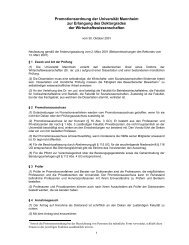The returns to cognitive and non-cognitive abilities in Germany
The returns to cognitive and non-cognitive abilities in Germany
The returns to cognitive and non-cognitive abilities in Germany
You also want an ePaper? Increase the reach of your titles
YUMPU automatically turns print PDFs into web optimized ePapers that Google loves.
personality dimension. 7 LOC is surveyed with ten items (cf. Table A1 <strong>in</strong> the Appendix) of<br />
which four measure <strong>in</strong>ternal LOC <strong>and</strong> six relate <strong>to</strong> external LOC. 8 Positive <strong>and</strong> negative<br />
reciprocity are asked for by three items respectively. <strong>The</strong> FFM <strong>in</strong>dica<strong>to</strong>rs as well as the LOC<br />
<strong>and</strong> reciprocity items are <strong>to</strong> be answered on 7-po<strong>in</strong>t Likert type scales (1 – “disagree<br />
completely” (LOC) / “does not apply <strong>to</strong> me at all” (FFM, reciprocity) <strong>to</strong> 7 – “agree<br />
completely” (LOC) / “applies <strong>to</strong> me perfectly” (FFM, reciprocity)). <strong>The</strong> basis for the<br />
personality measures employed <strong>in</strong> this analysis are generated by st<strong>and</strong>ardiz<strong>in</strong>g the average<br />
score from the dimension-specific questions on FFM, LOC <strong>and</strong> reciprocity. 9<br />
Summariz<strong>in</strong>g both personality trait scores <strong>and</strong> <strong>cognitive</strong> ability test scores, Figure 1<br />
shows the distributions of age-st<strong>and</strong>ardized scores for both the <strong>cognitive</strong> ability measure <strong>and</strong><br />
the personality traits for females <strong>and</strong> males separately. 10 <strong>The</strong> graphs show that a few of the<br />
traits are not normally distributed, most obvious for conscientiousness which is left-skewed.<br />
Furthermore, gender differences are visible with respect <strong>to</strong> agreeableness <strong>and</strong> neuroticism.<br />
Results from t-tests <strong>and</strong> KS-tests <strong>in</strong> addition <strong>in</strong>dicate that the two mentioned traits as well as<br />
openness, extraversion, <strong>and</strong> the two reciprocity items are differently distributed for males<br />
<strong>and</strong> females. <strong>The</strong> scores for conscientiousness, external locus of control <strong>and</strong> <strong>cognitive</strong><br />
<strong>abilities</strong> on the other h<strong>and</strong> have the same distribution function across gender.<br />
[Figure 1 about here]<br />
Estimation methods<br />
In the follow<strong>in</strong>g, we exam<strong>in</strong>e the <strong>returns</strong> <strong>to</strong> <strong>in</strong>dividuals’ <strong>cognitive</strong> <strong>abilities</strong> <strong>and</strong><br />
personality us<strong>in</strong>g augmented M<strong>in</strong>cer-type earn<strong>in</strong>gs regressions. <strong>The</strong> estimated earn<strong>in</strong>gs<br />
functions are based on the typical form:<br />
y = x′ β + c′<br />
γ + u , (1)<br />
ln i i i i<br />
14















